Periodontal disease (also known as gum disease) is an infection of the gum and bone that support the teeth. If periodontal (perry-oh-DON-tal) disease is not treated, it can get worse and lead to tooth loss. Periodontal disease may not be painful. You may not be aware of a problem until your gums and supporting bone are damaged.
Fortunately, periodontal disease often can be treated with a deep cleaning called “scaling and root planing.” This brochure will tell you why treating periodontal disease is important, and how it can help you keep your teeth.
WHAT CAUSES PERIODONTAL DISEASE?
Periodontal disease is caused by plaque, a sticky film of bacteria that is always forming on your teeth. If teeth are not cleaned well, plaque bacteria can cause your gums to become inflamed.
Inflamed gums can pull away from the teeth, forming spaces called “pockets.” These pockets trap more plaque that cannot be removed with toothbrushing. If the pockets are not treated, the periodontal disease can get worse.
Diseases such as diabetes and AIDS can place a person at higher risk for periodontal disease. Tobacco use also increases your risk of developing periodontal disease, and treatment may be less successful if you continue to smoke or chew.
Stages of Periodontal Disease
Healthy gums and bone hold teeth firmly in place. Gums hug the teeth tightly. There is little or no buildup of plaque and tartar (calculus).
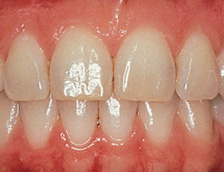
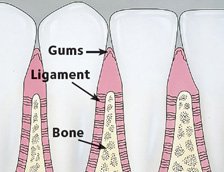
Gingivitis (jin-ja-VY-tis) is the early stage of periodontal disease. It develops as plaque irritates the gums. The gums become red, tender, swollen and likely to bleed. Gingivitis can usually be reversed with a professional dental cleaning plus improved oral hygiene. If plaque is not removed, it can harden into tartar.
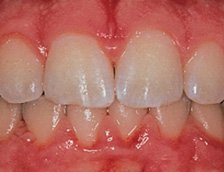
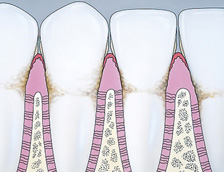
Periodontitis (perry-oh-don-TIE-tis) is a more serious condition that can develop if gingivitis is not treated. Periodontitis happens over time as plaque inflames the gums. The gums and bone that support teeth are damaged. Unless treated, the affected teeth may become loose and even require removal by a dentist.
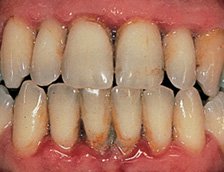
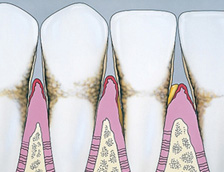
HOW IS PERIODONTAL DISEASE DIAGNOSED?
If you schedule regular dental exams, your dentist can catch periodontal disease before the gums and the bone supporting your teeth are severely damaged.
- During a periodontal evaluation, the dentist or hygienist uses a periodontal probe to gently measure the spaces between the teeth and gums. In a healthy mouth, this space (pocket) is usually less than three millimeters deep. Very deep pockets are a sign of advanced periodontal disease.
- He or she usually takes x-rays to check the bone supporting the teeth. Low bone levels can be a sign of damage from periodontal disease.
- If periodontal disease is diagnosed, your dentist may provide treatment or may refer you to a periodontist (a dentist who specializes in the diagnosis, prevention and treatment of periodontal disease).
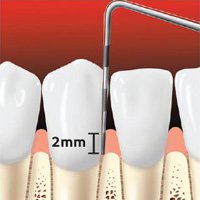
Periodontal probe of healthy gums.
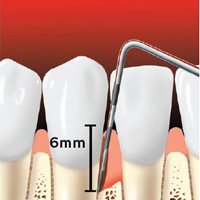
Periodontal probe in a periodontal pocket.
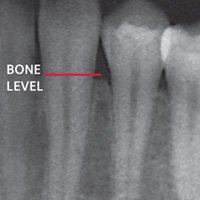
X-ray showing supporting bone.
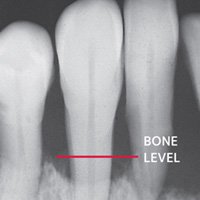
X-ray showing periodontal bone loss.
HOW IS PERIODONTAL DISEASE TREATED?
Periodontal treatments depend on the type of the disease and how severe it is. If the disease is caught early (when it is gingivitis), and no damage has been done to the supporting structures under the teeth, you may simply need a professional cleaning. The dental team can give you tips for improving your daily oral hygiene.
Even with these measures, some patients develop more severe periodontal disease. The first step in treating the disease usually involves a special deep cleaning called “scaling and root planing.” In this treatment, the dentist removes plaque and tartar down to the bottom of each periodontal pocket. This treatment may be done over several visits, depending on your needs.
The root surfaces of the teeth are then smoothed (or “planed”) to allow the gum tissue to heal and reattach to the teeth. This treatment also may take more than one visit.
Your dentist may recommend medications to help control infection and pain or to aid healing. These can include a pill, a mouthrinse or a medication that the dentist places directly into the periodontal pocket after scaling and root planing.
If you smoke or chew tobacco, it is important to quit. Ask your dentist or physician for information about ways to stop.
Another dental visit will be scheduled within a few weeks or months after your last scaling and root planing treatment. At this visit, your dentist or hygienist will look at your gums to see how they have healed. He or she will measure the periodontal pockets again. If the pockets have gotten deeper and the supporting bone is lost, more treatment may be needed.
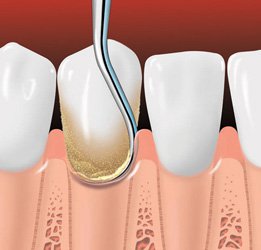
Scaling removes plaque and tartar from below the gumline.
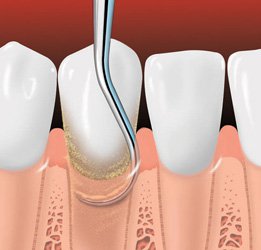
Root planing smoothes the tooth root and helps the gums reattach to the tooth.
CARE AFTER TREATMENT
Once your periodontal treatment is completed, your dentist may recommend more frequent checkups and cleanings. Regular dental visits and deep cleanings are important to keep periodontal disease under control. In some cases, your appointments may alternate between your general dentist and periodontist.
ORAL HYGIENE AT HOME
Good oral hygiene at home also is very important to help keep periodontal disease from becoming more serious or from coming back. Daily home cleaning helps keep plaque under control and reduces tartar buildup.
- Brush your teeth twice a day with a fluoride toothpaste.
- Floss your teeth (or use another between-the-teeth cleaner) once a day.
You don’t have to lose teeth to periodontal disease. Brush, clean between your teeth, eat a healthy diet and visit your dentist regularly for a lifetime of healthy smiles.
